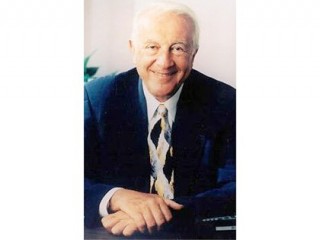
Robert C. Atkins biography
Date of birth : 1930-10-17
Date of death : 2003-04-17
Birthplace : Columbus, Ohio, U.S.
Nationality : American
Category : Science and Technology
Last modified : 2011-09-15
Credited as : physician, cardiologist, Atkins Diet
0 votes so far
This low carbohydrate diet was unconventional and ran counter to most of the tenets of Western mainstream medicine. The medical community berated the Atkins diet for years as dangerous, but research from a few small studies released in February of 2003 found that cardiovascular risk factors decreased and cholesterol profiles actually improved.
Though Atkins' first book, Dr. Atkins' Diet Revolution: The High Calorie Way to Stay Thin Forever was published in 1972, "low carb" didn't become a buzzword until the late 1990s and early 2000s, after publication of Dr. Atkins' New Diet Revolution in 1999. Various editions of the book sold more than 15 million copies, making it one of the top 50 titles ever published. It spent five years on the New York Times 's best seller list.
Atkins was born in Columbus, Ohio, and moved to Dayton, Ohio, in the seventh grade. His father was a restaurant owner. As a teen, Atkins considered becoming a comedian and even performed one summer at resorts in the Adirondacks after graduating from college. He received a pre medical bachelor's degree from the University of Michigan in 1951. He went on to specialize in cardiology at Cornell University Medical School, earning his medical degree in 1955 after training at Rochester and Columbia University Hospitals and St. Luke's Hospital in New York.
In 1959, Atkins opened his own practice on the Upper East Side of Manhattan in New York City. He told an interviewer once that he began a low carbohydrate diet in 1963 to counter obesity and depression. The program he followed was initiated by Dr. Alfred W. Pennington, who found that 20 test subjects lost an average of 22 pounds in 100 days by eliminating sugar and starch. A version of the diet was published in the Journal of the American Medical Association.
After six weeks on the plan, Atkins said, he lost 27 pounds and turned his practice into an obesity clinic. He appeared on the Tonight show and in several magazines, including Vogue in 1970. This led to one million requests for copies of his diet plan. The thrust of the diet is that people may eat as much as two thirds of their calories from fat, but very few carbohydrates which is more than double the usual recommendation. Atkins claimed that without carbohydrates, the body would burn its own fat. Meanwhile, in 1973, the American Medical Association labeled the diet "potentially dangerous." Other critics over the years included the American Dietetic Association and the American Heart Association. These groups and others claimed that the Atkins plan wouldn't work over the long term and that it could cause health problems ranging from bad breath and constipation to osteoporosis and heart problems.
Between the late 1970s and the 1990s, Atkins opened an alternative healing clinic and fell out of the public eye, although he did continue to publish books. During this time, he was sued several times by unhappy clients, and temporarily lost his medical license in 1993 after another doctor filed a complaint. The doctor treated the patient for an air bubble that had blocked a vessel in her brain after she received ozone treatment from Atkins, who said it would kill cancer cells. A judge reinstated the license.
When Atkins released his 1999 book, adherents included celebrities like Jennifer Aniston and Brad Pitt. Restaurant goers followed, brushing away the breadbasket in favor of steaks, bunless hamburgers, cheese, and eggs. The diet hit at a time when more Americans were overweight than ever before: The Journal of the American Medical Association reported in 2002 that 64.5 percent of Americans were over-weight, compared with 55.9 percent in 1994.
However, health concerns resurfaced among medical professionals. The American Heart Association in 2001 issued a strong recommendation against following high protein diets such as Atkins' and others, including the Zone, Protein Power, and Sugar Busters. Atkins' final book, Atkins for Life, published posthumously, addressed the controversy by advocating a diet with more lean meats and nutrient rich vegetables. He also advocated taking 20 nutritional supplements a day, and he himself took 60 daily.
No long term studies on the Atkins diet had been completed by the time of the author's death, so it was still unknown whether people could maintain the weight loss over time and not suffer negative health effects. Six smaller studies, including one conducted at Duke University, showed that subjects on the Atkins diet lost weight and lowered their cholesterol without harming their health.
The National Institutes of Health in 2003 began a large study, but that same year, the Journal of the American Medical Association published a report by a team of doctors from Yale and Stanford universities suggesting that Atkins dieters lost weight because they ate fewer calories overall, not because they consumed fewer carbohydrates. The study did not espouse or condemn the Atkins plan.
One year before his death, Atkins suffered a cardiac arrest and had to be revived. In an official statement, he attributed it to cardiomyopathy, a heart condition caused by an infection rather than clogged arteries. At age 72, Atkins died on April 17, 2003, in New York, New York, after slipping on pavement and suffering severe head injuries. Subsequently, he underwent surgery to remove a blood clot from his brain, but never regained consciousness. He is survived by his wife, Veronica, and his mother, Norma.
















